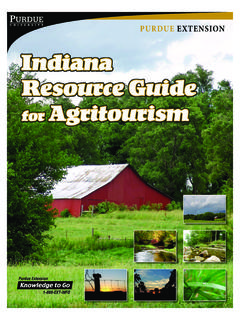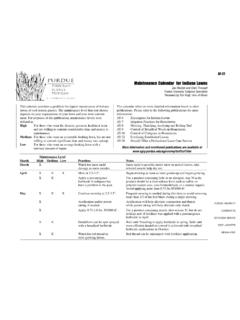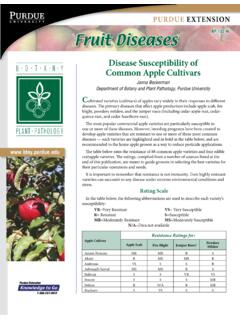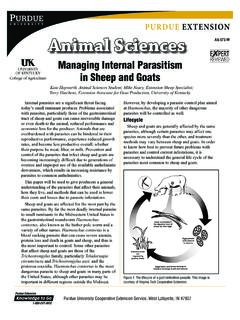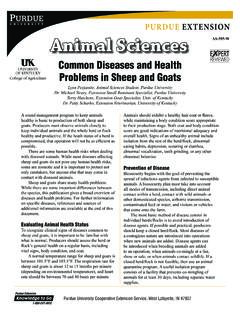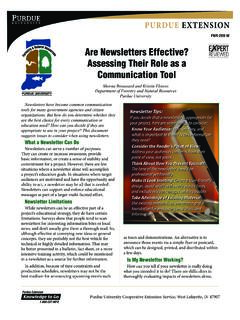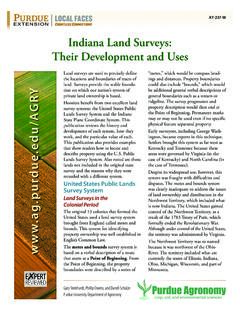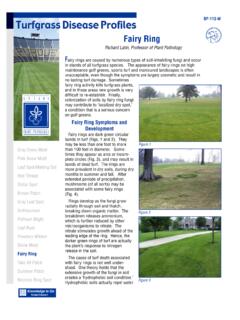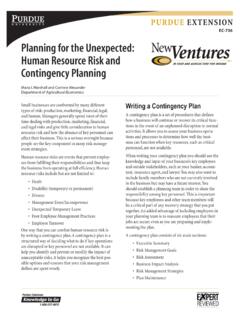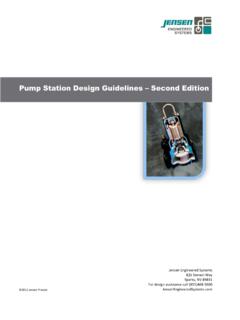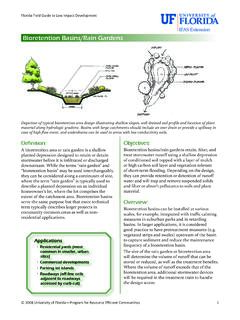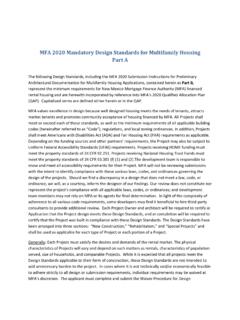Transcription of Tree Appraisal and the Value of Trees - Purdue University
1 FNR-473-WTree Appraisal and the Value of TreesAuthorLindsey PurcellRCA, BCMAU rban Forestry Specialist, Purdue University Department of Forestry & Natural ResourcesForestry and Natural ResourcesContributorJeffrey LingRCA, TPAQA rborwiseTrees provide many benefits and great Value to property owners in functional, aesthetic, social, environmental, and even economic ways. Functional benefits include mitigating climate change by storing carbon, removing pollution from the atmosphere, managing stormwater runoff, and improving air quality. Trees provide oxygen and many other benefits such as shade, which can impact home cooling collective Value of Trees makes a difference in people s health and quality of life in cities and towns everywhere. In fact, it is also possible to calculate the benefits provided by each individual tree in any landscape by visiting the MyTree website at is the Value or worth of a tree?
2 Value may be defined as the monetary worth of an item at a given time with the expectation of benefit. A dollar figure in a formal tree Appraisal , which provides an estimate or approximate Value , can quantify many of these benefits. However, a tree s true worth may be judged by a sale or, in litigious situations, a court valuation of Trees and living landscape components requires training, expertise, and experience. Just like any real estate or professional appraiser, plant appraisers have the responsibility of assigning values and preparing to defend, explain, and support their you are pursuing tree valuation, you should retain the services of a qualified consulting arborist who can properly apply methods and techniques that best relate to your situation. Three methods used to appraise Trees and landscapes Cost Approach, Income Approach, and Sales Comparison Approach are described in the Guide for Plant Appraisal , 10th edition.
3 Authored by the Council of Tree and Landscape Appraisers (CTLA), published by the International Society of Arboriculture, and endorsed by the major arboriculture and horticulture organizations, this guide represents a critical resource for sound plant the functional limitations of the tree and its interaction with site of the structural integrity and overall health of Trees is an important component of the Appraisal Appraisal FNR-473-WWhy should a tree be appraised?Tree Appraisal assigns monetary importance to any tree on a site that is indicative of the tree s contribution to the site, especially when construction may affect plants on the property. Basically, an Appraisal constitutes developing an opinion of Value or cost of a site s landscape elements. An Appraisal s purpose is defined by a client s needs, which may include unexpected losses, tort claims, insurance claims, tax deductions, real estate assessment, and proactive best time to conduct an Appraisal is prior to any incident with, or damage to, a tree.
4 However, most appraisals occur after a tree has been removed or damaged. Such situations require additional investigation and might include a determination of pre-casualty Value or comparative sampling on a local basis. Provided they are available, previous site records, tree assessments, site reviews, and even witnesses can help determine a tree s pre-damage gathering every relevant fact, the appraiser determines the appropriate method of Appraisal and provides an unbiased valuation. The appraiser should document all activities related to this process, from initiating client contact and establishing a tree s background information to inspecting a site, collecting data, and formulating a reasonable and defensible technique outlined in the Guide for Plant Appraisal is the Trunk Formula Technique (TFT), which appraises larger Trees in the landscape within the Cost Approach.
5 Used by professional appraisers, this technique extrapolates costs to purchase the largest commonly available nursery tree relative to the size of the appraised tree. This means the costs of a nursery tree can be proportionally increased to infer the cost of a larger tree. Small Trees being appraised, less than 4 caliper inches or an 8-foot conifer, would be figured at retail Value based on the TFT application is a calculation generated by using unit tree costs. The unit tree costs required for this formula must be obtained either from local resources as determined by the consulting arborist or collected by the Regional Plant Appraisal Committee (RPAC). The RPAC is comprised of industry experts who are typically associated with their local chapter of the International Society of Arboriculture. This committee gathers data based on statewide information to determine unit costs for commonly available Trees , the Trees obtainability, and their functional limitation in your Appraisal FNR-473-WThere may be external limitations outside the tree owner s control such as the site location that can affect tree diameter tape aids in calculating tree information and data is a baseline for species; it is the responsibility of the appraiser to determine tree species ratings and wholesale values based on availability in a for common Indiana tree species can be found at the Indiana Arborist Association website ( ).
6 Statewide surveys have determined that for the computations needed for cost techniques, the largest commonly available, transplanted deciduous tree would be caliper inches with a unit tree cost of $ a tree s Value using the TFT begins with multiplying the cross-sectional area of the tree by the unit tree cost. To determine a tree s cross-sectional area, you must first calculate the tree s diameter at breast height (DBH). DBH is measured using a special diameter-measuring tape wrapped around the tree at feet above the ground. In lieu of the special measuring tape, regular measuring tape can be used to determine circumference and that number divided by to calculate DBH. Once the diameter is determined, divide by 2 to get the radius. Multiplying that number by the unit tree cost will then provide the overall basic example: If a tree has a diameter of 20 inches, the computation would be 10 x 10 x equaling 314 inches.
7 Multiplying 314 by a unit cost of $ equals $11,828, which is the overall basic cost. However, this is not necessarily the Value of the tree. Additional factors will affect a tree s Value , which is why a professional appraiser is recommended for an accurate Value . Factors in AppraisalsDepreciationAccurate Appraisal values will reflect the application of depreciation factors. Professional appraisers use depreciation in their valuation process to justify differences in a new, perfect tree compared to the appraised tree. This will account for less-than-ideal tree characteristics, placement in the landscape, or the site it occupies. The three depreciation factors or variables include actual condition of the tree, functional limitations, and external it relates to a depreciation factor in tree valuation, condition refers to the assessment of overall tree health.
8 Professional appraisers will assess a tree s vigor, looking for Properly placed Trees can add Value to your home and Appraisal FNR-473-Wthe presence of pest issues and any stress symptoms. They also will consider the tree s structure and form reviewing branch habits to determine if there is a strong, stable structure with good branch attachments and spacing and if the tree has a good form for its species. Each species has a typical genetic form, or normal traits, representative of its species. However, most Trees are not normal or typical. See Table 1 for more information on rating the limitationsFunctional limitations applied as depreciation factors in tree valuation are primarily associated with the tree itself or the site on which it s located. These are factors that may limit future growth, development, and overall health.
9 Site conditions and placement, such as proximity to utility lines, could limit full development due to necessary pruning for clearance. Professional appraisers will investigate any genetic limitations related to the genus and species itself. These include naturally poor branch systems, susceptibility to pests, or invasive tendencies as examples that would depreciate a tree s limitationsExternal limitations applied as depreciation factors in tree valuation include issues outside the control of the tree s owner that may affect sustainability, structure health, or tree form. One example of external limitations would be environmental circumstances such as water availability, issues with threats from pests, or utility vegetation management concerns where there are impending conflicts between power lines and a tree.
10 Additionally, local ordinances, easements, or rights of ways may be factors that affect life expectancy. When applying depreciation factors toward overall basic cost, a professional appraiser will assign a rating to each of these three depreciation categories: condition, functional limitations, and external limitations. The overall basic cost is multiplied by the determined Value in each of these three categories to estimate the depreciated cost the final functional reproduction Value using the Trunk Formula Appraisal FNR-473-WTree appraisals must be reasonable and Trunk Formula Technique is only one method to appraise large Trees . It is important to realize that estimates of a tree s Value may not be proportionate to the Value of a property or what would actually be paid for a tree. Studies estimate that Trees may account for up to 15% of a residential property s Value .
